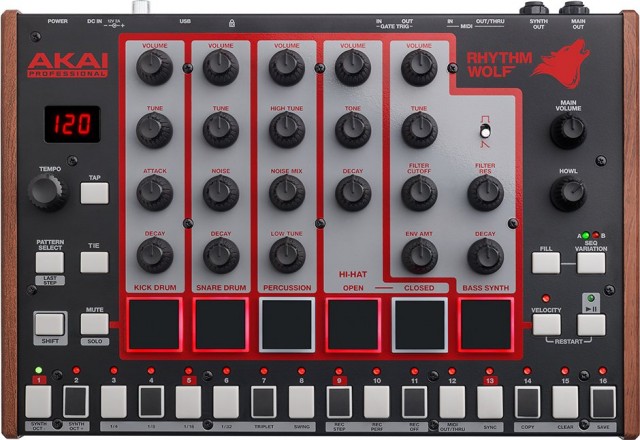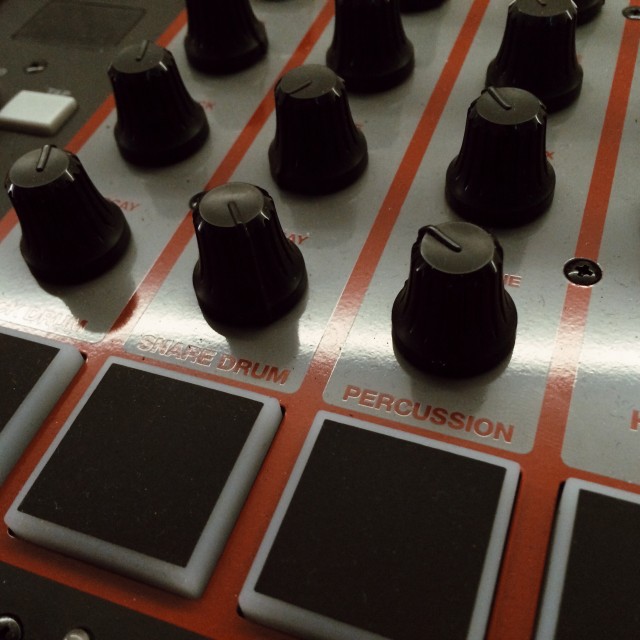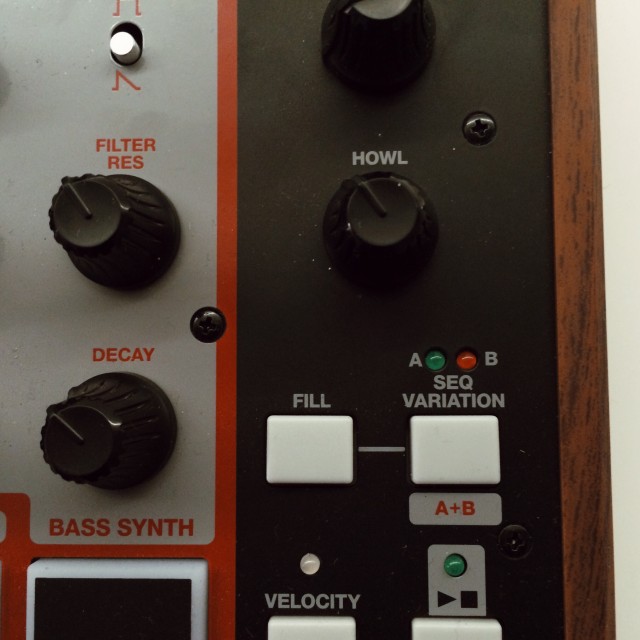Dance music, it seems, has come full circle. Techno’s roots began with affordable oddball hardware, abused into new genres. And now, the appetite for cheap little boxes that make grooves is back.
But does “cheap” and “analog” always make for a winner? Well, not necessarily. But let’s find out why.
This is the AKAI Rhythm Wolf. When we first saw it, it was clear people would want it, because physically, visually, it has the things you’d want – even before you get to the accessible price. There are velocity-sensitive pads for each part, coupled (cleverly) with x0x-style buttons for simple 16-step patterns (which you can chain into 32-step pattern). There are the requisite controls for changing step length, and recording step sequences or performances. There’s ample I/O – proper MIDI in/out and thru (plus MIDI over USB), gate trigger in and out, and separate mono outputs for the synth and drums.
This is the body of a usable drum machine. It has all the controls you’d want, in a form factor people are bound to love.
Take the Rhythm Wolf out of the box, and until you plug it in, you’re still likely to be reasonably happy. The knob caps are somewhat unpleasant to tweak, but the build is otherwise great for a $200 piece of kit. It’s heavy and solid, with a metal case, and oddly has a bigger footprint than a new Elektron. The pads work just fine (even if AKAI now calls any pads “MPC”), and the triggers respond with a satisfying click. I’ll even excuse the strange plastic faux-wood end-caps; they don’t do any harm.
Of course, you’re probably not going to use a drum machine without plugging it in, and that’s where things suddenly go very wrong. There’s no gentle way to put this. It sounds not good.
The bass drum is fine. You can pitch it down and get something fairly workable. Personally, I feel it doesn’t compare with other offerings, and now thanks to KORG, that includes the dirt-cheap volca BEATS with its floor-rattling kick. But it’s usable.
The snare drum and percussion are, in my opinion … not fine. At best, they resemble sort of white noise generators; at worst, they’re flat and unusable. The hats and cymbals are even worse: noise-y, clang-y affairs that qualify as what they are, but only just.
The upshot is, even with the full range of knobs, I wasn’t able to find a set of variations I’d want to record. The sounds are perfectly fine for a $50 boutique kit, but not something that has an AKAI badge.
Then there’s the bass synth, which seems to crowd out an already-flawed design with something you don’t really want. The single-oscillator affair starts out sounding thin, so you think, perhaps, you’ll add the filter and it’ll improve. But the more you add resonance, the quieter the filter gets – the opposite of what you want. As mediocre as the drum parts are, the synth seems like wasted space.
Adding insult to injury, the so-called “Howl” knob just seems like overdriving gain: things get a bit louder and distorted and mostly you add copious amounts of background noise.
In fact, it’s all so shocking, I had a hard time telling anyone about it. If I described it without actually playing it, they didn’t believe me. I put off sitting down to write this review, partly because I knew I’d need to make some sound samples or video, and I really didn’t want to. (It doesn’t help that I’m my own editor, and no one from AKAI called wondering where the loaner was.)
But, then in my inbox, I got this video. And sure enough, it says exactly what I already said. I was relieved: maybe I’m not crazy.
The creator, space travel made easy, doesn’t mince words:
The other week I got myself an Akai Rhythm Wolf.
This was such a promising little drum machine but was one of the biggest let-downs I’ve ever had with hardware.
Watch the video to find out why I thought it so piss-poor.
http://www.spacetravelmadeeasy.com
He gets further than I did: I was already so unhappy with the synth that I didn’t bother to think about whether it would hold its tune across its multi-octave range. But it doesn’t. Yikes.
All of this is a shame, because recording patterns itself on the Rhythm Wolf is great fun, combining live performances on the pads with the x0x steps at the bottom. There actually isn’t another standalone drum machine I can think of for less than a grand that has something like this apparently-obvious combination of controls. The one kit that can compete is, ironically, Akai’s MPC. But they seem to have exited the standalone drum workstation market apart from entry-level stuff.
As it happens, you can use the pads and step triggers to transmit MIDI, both over USB and the onboard MIDI ports. But in another disadvantage to AKAI’s analog approach, you can’t use any of the 21 onboard parameter knobs to transmit MIDI – they’re analog only. So I don’t think you’d buy the Rhythm Wolf as a drum machine.
The box is fairly big and potentially hackable, so it’s conceivable someone would mod this into something, well, better. But they might just build their own drum machine instead.
Not everyone is unhappy with it. Presumably because it does make some noises, and the patterns are fun to play, and it has knobs, I’ve seen some happier YouTube users, and more power to you. Richard Devine used it as sort of a weird modular source for his Eurorack rig … but then, much of the actual sound is coming from elsewhere.
What you could do is of course route it through a whole bunch of guitar pedals. That, at least, sounds rather good, and then you can have fun. And in fairness, a lot of electronic instruments sound better with processing. So someone will find a way to make this their own.
So I’d love to be wrong… maybe, in fact, this review will be a bit like early reviews of the 808, and you’ll find a way to abuse this box into something useful.
But I like AKAI – and drum machines, and you – too much to hold back on this review. You could spend your $200 on almost anything else. Any number of digital drum machines will sound radically better. AKAI’s current MPX or XR20 are just sample playback machines, for instance, but they have usable sounds and I think you’d get more use out of them. You might even find someone with an old MPC you could unload. Or you could buy a controller and work with software (again, even from AKAI).
And KORG’s volca BEATS will go, essentially, unchallenged. It’s not an even-sounding drum machine – sometimes it sounds frankly weird and lo-fi, but at least it does so in an interesting way. If you want drum machine hardware with lots of hands-on controls and you’re on a sub-$350 budget, consider either the MFB 522 or the volca. They’re both great, and the volca should fit just about any budget.
Making hardware is hard. It’s not enough to make something work on paper; it has to sound good, too. And the Rhythm Wolf just seems like a good idea that wasn’t fully executed, or fully finished.
The surreal thing here is the marketing; AKAI is promoting the “fierce 100% analog signal path” of the Rhythm Wolf, perhaps in the hopes that you aren’t actually listening.
I think the Rhythm Wolf is going to be a really big seller, whatever I say. But let’s at least, some of us, declare two things.
First, “analog” does not mean “sounds good.” That does an injustice to the hard, mysterious, and pleasurable work of making great-sounding analog gear, and the many possibilities of digital gear, and that both are routes to solving problems. (Wood is nice; you can also make something poor out of wood, or something beautiful out of plastic or bamboo.)
Second, “cheap” should not mean lowering our standards. Someone could serve me a junior McDonald’s Happy Meal and then punch me in the face. It’d be cheap, but I’d get very angry. This isn’t that bad, but at least feels like a Happy Meal without a free toy.
The Rhythm Wolf is worth talking about, because it could have been something great. In fact, I hope AKAI have a second go at this. I wish they had simply gone with digital sound sources combined with hands-on controls – really, there’s no reason that couldn’t work. But whatever they do, I’d love to see AKAI’s name on a drum machine worth endorsing. This just isn’t it, by a longshot.
Anyway, here’s another jam from space travel made easy:
And Richard Devine, going rather wild with this. (I agree with what he says about “analog” gear, just not necessarily that that has to mean analog signal path – it can mean digital instruments, and controllers for software, too, just so long as you’re using your hands.)
http://www.akaipro.com/product/rhythm-wolf
Addendum: Well, that has certainly brought out discussion. And it seems that people either are forgiving of the Rhythm Wolf’s eccentricities and are happily making music with it, or they react rather negatively as I did – and without a whole lot of middle ground. It’s good to see some discussion, though. I’d much rather talk frankly about what we think of gear than have the same vanilla review of everything – and the surprising upshot is that the criticism here appears to be giving the Rhythm Wolf some impassioned advocates.



